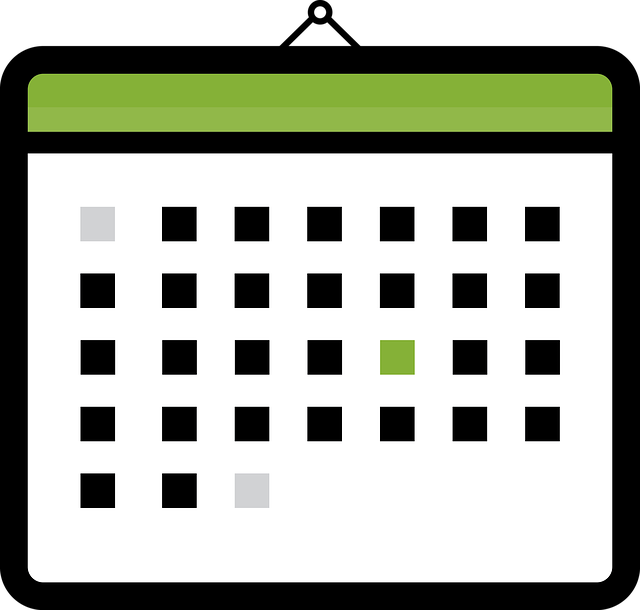I’d really like to be able to do this, and I know I will benefit from it, but I do not have time or I did not find time to try it…
How much time do you plan to take to read this blog post? Will you read until the end? Completely or the headlines only?
If you do not have time now, please do not bookmark me. Set a 10 minutes time slot in your agenda to really read it next week.
Too Long; Didn’t Read
Clean your to-do list.
Do it now.
But also, do plan the ‘must-do’ now in your agenda, and when the times come, do it.

Figure 1: Calendar - Image by Samuel1983 on Pixabay
You want to learn a new language, a new method, a new package?
You do not need to take all this long week-end afternoon to try.
Set a 30 minutes slot between 13:30 and 14:00 every thursday, every week in your agenda now. If you did not completely explored this stuff during the first slot, you’ll be able to continue next week.
There is no need to put you under pressure when learning new things. You will include them progressively in your daily workflows. No need to rush.
How many items do you have on your to-do / must-do?
You know you cannot do or try everything, you know you will have to do some choices at some point. You cannot keep your “that would be nice thing to do” list as long as the one you currently have.
Start cleaning that list now. Be brave. That is not an easy thing to give up on some cool things, but you know you’ll never have time to do them all. Are they really worth it? Do you really want to keep such a long guilt-inducing list?
Clean it now.
Close those many browser tabs you will never read…
What if you really need to do the task?
I’d really like to get started. I’d really like to apply what I learnt with you, but I’m under pressure, and I prefer to continue with Excel / ArcGIS / scripts without documentation, tests, … because I am currently faster with these tools and I can answer my bosses. I’ll practice the tutorial later…
I hear this sentence so many times during my tutorials, presentations, after-courses discussions.
You know this new thing will highly improve your process.
Indeed, you already took 5 days of your time to be taught how to use R for data wrangling; how to manipulate spatial data with R; how to create correctly documented, tested, versionned, shareable packages with R; how to build production-ready Shiny application, …
You know that this will allow you to deliver reports, applications, code more quickly, more properly.
You know that it will make your work more meaningful, because you will spend less time clicking, copy-pasting and sending between multiple software programs. You’ll have more time to think, explore your data, and use your expertise on why you’re making these observations.
Connect Excel to the remote SQL database with this old plugin. Create this graph on Excel with multiple clicks that you re-create the same way every year. Copy it in Word. Create a map in QGIS. Copy it in Word. Rework the output in PDF using InDesign. Change one value in the original dataset. Start again all this procedure. Be sure not to forget one place in the output where this data appeared. Send a mail with the new version of the scripts and the reports. Gather modifications of your colleagues in Word, on paper, on annotated PDF. Start again the procedure…
Why do you still think you do not have time to change your habits? Why should others change their habits before you do?
How to practice what you just learnt, without reducing your productivity?
Define a small regular time slot to try.
I perfectly understand why you are in this situation. I know that you really are under pressure. I know that you are more comfortable with the tools you’ve been using for the last 10 years. And currently, you are really quick to do it. You are quicker to do it the old way than with the way I just taught you.
But if you want to go on the next level, you have to take some time to do it.
What I recommend is to set up a 30 minutes slot each week or two 15 minutes time slots. That is not so big in your agenda, but so important for your future everyday life, otherwise, you would not have come to my training. Try it on a regular basis, like, now for instance, open up your agenda, and set that, between 13:30 and 14:00 every Thursday, you will practice your new skills.
Start a timer. When the 30 minutes slot is off, you stop. Wherever you are. This is not about finishing or succeeding in some goals during this slot. This is only about practicing. You already have enough pressure at work, you do not need to put some extra pressure in this time slot.
This slot is for you, and for yourself only.
What do I do in such a small regular time slot?
Try again an exercise you did during your tutorial, and start it over. You do not have to finish it this week.
Use one of your analysis you did this week using your old way. You already sent it to your managers, so no more pressure. Use the time slot to think on how you would have done it if you used the new method you learnt? Start this week, continue next week. At some point, you will have finish re-coding the process, and next month, you will be way quicker to create the new monthly report with your new method.
You already retried all exercises, and you do not have a proper work case? Use one of these #TidyTuesday datasets. I am sure one of it will suits you. Start exploring the data on your first time slot. Next week, you will create a first graph with the dataset and the week after you will improve it. Then, you may be happy enough to share it on Twitter with #TidyTuesday, even if it is 3 weeks after the release. Who cares?
You do not think you have enough material to practice package development? Use any of your R scripts. Take a small part. Transform it as a function. Create an reproducible exemple to use it. Add a small unit test. If you wrote these in a Rmarkdown file, you may already have written a package. See how {fusen} can help you to write a package from a single Rmd file. Again do not blame yourself if you did not finish during the 30 minutes time slot, you know you’ll be able to continue next week, because there is another time slot waiting for you.
You want to go further into package development using git, but do not want to be alone? See how you can participate to other packages development. There are thousands of open issues on GitHub / GitLab for your prefered packages. You can surely help with one of these. For instance, see the ThinkR Dashboard of all our issues on GitHub. You can also choose to only correct typos in the documentation, developers would be so happy about it.
You do not think your Shiny Application requires {golem} but you still would like to try? Just try. Create a simple ‘golem’ following the guides on this page. Put your server part in “app_server.R” file, put your ui part in “app_ui.R” file. You created a Shiny App in a ‘golem’. That’s it. Now, you can explore the possibilities. You can also take one of the simple Shiny App of the RStudio Shiny examples and try to golemize them as Colin Fay did there.
What are you waiting for?

Open your agenda, and start to plan. One 30 minutes slot or two 15 minutes slots, the same day every week.
Try it during one month and see what comes out of it.
I am sure you all have so many ideas of things to try during these time slots. But do not put to much in it.
I personally have a 30 minutes time slot every monday between 8:30 and 9:00 to work on {fusen}. I may not address much issues, not even one usually. But this makes me in a great mood to start my week.
I’ll finish this blog post with an analogy from one of my tutorial attendees:
It’s like the story of the lumberjack who has to cut down many trees. He is under pressure so he cuts, he cuts. But he doesn’t have time to sharpen his saw. He doesn’t take the regular few minutes to do it because he is asked for more wood. However, as time goes by, the saw cuts less and less and he has to put more and more effort in order to cut the required quantity.
What do you think will fail first? The man or the tool?
Citation:
For attribution, please cite this work as:
Rochette Sébastien. (2021, Nov. 28). "I do not have time (to practice)". Retrieved from https://statnmap.com/2021-11-27-i-do-not-have-time-to-practice/.
BibTex citation:
@misc{Roche2021Idono,
author = {Rochette Sébastien},
title = {I do not have time (to practice)},
url = {https://statnmap.com/2021-11-27-i-do-not-have-time-to-practice/},
year = {2021}
}

